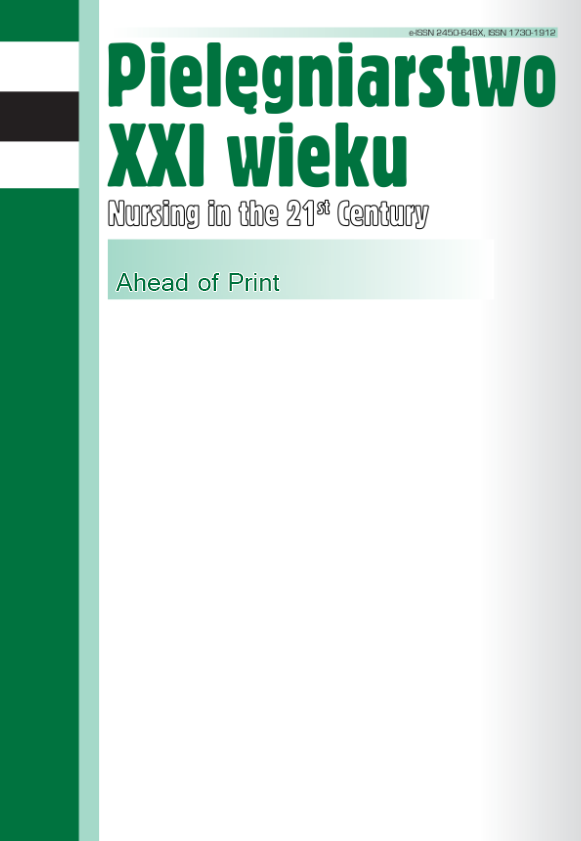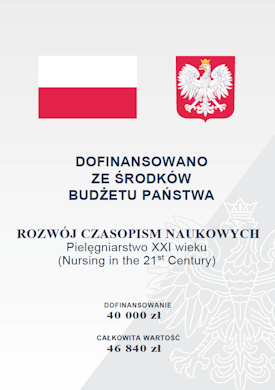Care for pregnant and postpartum woman with intrauterine fetal death in a full-term pregnancy
DOI:
https://doi.org/10.12923/pielxxiw-2025-0014Keywords:
fetal death, midwife, grief, stillbirthAbstract
CARE FOR PREGNANT AND POSTPARTUM WOMAN WITH INTRAUTERINE FETAL DEATH IN A FULL-TERM PREGNANCY
Aim. The aim of the article is to present a care plan for a pregnant and postpartum woman who has experienced intrauterine fetal death, based on an individual case study.
Material and methods. The paper uses a case study method to describe a patient with intrauterine fetal death in a full-term pregnancy. The care plan includes interview techniques, medical documentation analysis, observation, clinical nursing indicators (C-HOBIC), and the Edinburgh Postnatal Depression Scale (EPDS). The case follows CARE guidelines and utilizes ICNP® terminology, integrated with WHO-FIC.
Results. The main problems the patient experienced due to intrauterine fetal death were emotional consequences of the loss, such as stress, despair, and helplessness. This created a need for support, calm communication and appropriate management of further treatment. Additionally, the woman struggled with physical labor pain, sleep problems and lowered mood, which made self-care difficult. The interventions provided alleviated these complaints.
Conclusions. The presented plan of care allows for the implementation of individualized interventions, significantly supporting the patient’s adaptation to her new reality and the grieving process. Collaboration between the midwife and the multidisciplinary team improved the patient’s and her family’s quality of life. The findings emphasize the need for compassionate, evidence-based care that addresses the complex needs of women experiencing loss.
References
1. Schmalfuss JM, Matsue RY, Ferraz L. Women with fetal death: nurses’ care limitations. Rev. Bras. Enferm. 2019;72(3):365-368. https://doi.org/10.1590/0034¬7167-2018-0261
2. Rymaszewska J, Szcześniak D, Cubała WJ, et al. Rekomendacje Polskiego Towarzystwa Psychiatrycznego dotyczące leczenia zaburzeń afektywnych u kobiet w wieku rozrodczym. Część III: Podejście do utraty ciąży i nieskutecznego leczenia niepłodności metodą in vitro. Psychiatria Polska. 2019; 53(2):277-292. https://doi.org/10.12740/PP/104440
3. CME Info – Child Mortality Estimates. https://childmortality.org/profiles [Accessed: 10.11.2024].
4. Gardosi J. Preventing stillbirth: risk factors, case reviews, care pathways. Journal of perinatal medicine. 2022; 50(6):639-641. https://doi.org/10.1515/jpm-2022-0272
5. Główny Urząd Statystyczny. Baza danych. https://dbw.stat.gov.pl/baza-danych [Accessed: 10.11.2024].
6. Dera-Szymanowska A, Bręborowicz GH. Obumarcie płodu. [w:] Bręborowicz GH. Położnictwo i ginekologia. Warszawa: PZWL Wydawnictwo Lekarskie; 2020, s. 164¬170.
7. Tabor E, Bień A. Poród martwego płodu i strata dziecka. [w:] Iwanowicz-Palus G, Bień A. Techniki położnicze i prowadzenie porodu. Warszawa: PZWL Wydawnictwo Lekarskie; 2022, s. 586-599.
8. Management of stillbirth. ACOG Obstetric Care Consensus No. 10. American College of Obstetricians and Gynecologists. Obstet Gynecol. 2020; 135:e110-e132. https://doi.org/10.1097/AOG.0000000000003719
9. Bonasoni MP, Muciaccia B, Pelligra CB, et al. Third trimester intrauterine fetal death: proposal for the assessment of the chronology of umbilical cord and placental thrombosis. Int. J. Legal Med. 2022; 136(3):705-711. https://doi.org/10.1007/s00414¬022-02784-3
10. Burden C, Merriel A, Bakhbakhi D, et al. Care of late intrauterine fetal death and stillbirth: An international consensus guideline. BJOG: An International Journal of Obstetrics and Gynaecology. 2024; 50:1-41. https://doi.org/10.1111/1471-0528.17844
11. Fernández-Sola C, Camacho-Ávila M, Hernández-Padilla JM, et al. Impact of Perinatal Death on the Social and Family Context of the Parents. Int. J. Environ. Res. Public Health. 2020; 17(10):3421. https://doi.org/10.3390/ijerph17103421
12. Donegan G, Noonan M, Bradshaw C. Parents experiences of pregnancy following perinatal loss: An integrative review. Midwifery. 2023;121:103673. https://doi.org/10.1016/j.midw.2023.103673
13. Atkins B, Kindinger L, Mahindra MP, et al. Stillbirth: prevention and supportive bereavement care. BMJ Med. 2023; 2(1):e000262. https://doi.org/10.1136/bmjmed-2022-000262
14. Gindrich P. A child’s grief after the death of a sibling – a review of selected theoretical and empirical aspects. POW. 2020; 595(10):41-53. https://doi.org/10.5604/01.3001.0014.5972
15. Bakhbakhi D, Burden C, Storey C, et al. Care following stillbirth in high-resource settings: Latest evidence, guidelines, and best practice points. Semin. Fetal. Neonatal. Med. 2017; 22(3):161-166. https://doi.org/10.1016/j.siny.2017.02.008
16. Tataj-Puzyna U, Heland-Kurzak K, Sys D, et al. The Experiences of Midwives Who Attend Births by Women with Life-Limiting Fetal Conditions (LLFC): APhenomenological Research Study. Healthcare. 2023; 11(11):1540. https://doi.org/10.3390/healthcare11111540
17. Peracchini M, Agostini A, D’Angelo A, et al. The psychological support for women who underwent a stillbirth during their pregnancy: the quality of midwifery care. Riv. Psichiatr. 2023;58(4):143-153. https://doi.org/10.1708/4064.40476
18. Lesińska-Sawicka M. Metoda case study w pielęgniarstwie. Warszawa: Wydawnictwo Medyczne Borgis; 2009, s. 143.
19. CARE Checklist. The CARE Guidelines: Explanation and Elaboration Checklist. https://www.care-statement.org/checklist. [Accessed: 20.11.2024].
20. Kilańska D. Wskaźniki jakości opieki i ich wykorzystanie w praktyce. Zasady korzystania z narzędzi, ewaluacja i walidacja skal oceny statusu zdrowotnego. Łódź: Akredytowane Cent. Rozw. ICNP przy Uniwersytecie Medycznym w Łodzi; 2015, s. 1-10.
21. ICNP Browser. ICN – International Council of Nurses. https://www.icn.ch/icnp¬browser [Accessed: 20.11.2024].
22. Rozporządzenie Ministra Zdrowia z dnia 16 sierpnia 2018 r. w sprawie standardu organizacyjnego opieki okołoporodowej. Dz. U. 2018 poz. 1756.
23. Mess E, Bartoszczyk I, Jerczak B, et al. Poród martego dziecka. Sytuacja kobiety rodzącej w Polsce w świetle badania ankietowego. Medycyna Paliatywna. 2016; 8(4):182-185. https://www.termedia.pl/Porod-martwego-dziecka-Sytuacja-kobiety-rodzacej-w-Polsce-w-swietle-badania-ankietowego,59,29610,1,0.html
24. Kingdon C, Givens JL, O’Donnell E, et al. Seeing and Holding Baby: Systematic Review of Clinical Management and Parental Outcomes After Stillbirth. Birth. 2015; 42(3):206-218. https://doi.org/10.1111/birt.12176
25. Tsakiridis I, Giouleka S, Mamopoulos A, et al. Investigation and management of stillbirth: a descriptive review of major guidelines. J. Perinat. Med. 2022;50(6):796-813. https://doi.org/10.1515/jpm-2021-0403
26. Persson M, Hildingsson I, Hultcrantz M, et al. Care and support when a baby is stillborn: A systematic review and an interpretive meta-synthesis of qualitative studies in high-income countries. PLoS One. 2023; 18(8):e0289617. https://doi.org/10.1371/journal.pone.0289617
27. Mazur J, Kozakiewicz A, Porwit K, et al. Polska wersja kwestionariusza PTSD-8 w badaniach czterech grup zawodów medycznych. Med. Pr. 2024;75(1):45-56. https://doi.org/10.13075/mp.5893.01465
Downloads
Published
Issue
Section
License
Copyright (c) 2025 Anna Kullas, Anna Weronika Szablewska (Autor)

This work is licensed under a Creative Commons Attribution 4.0 International License.




